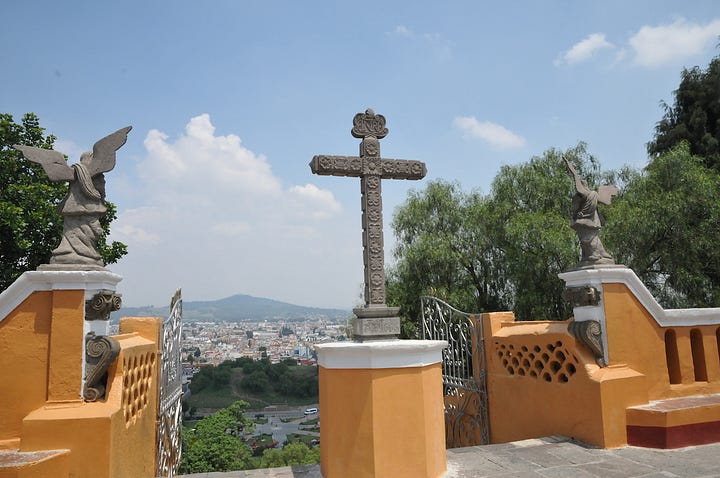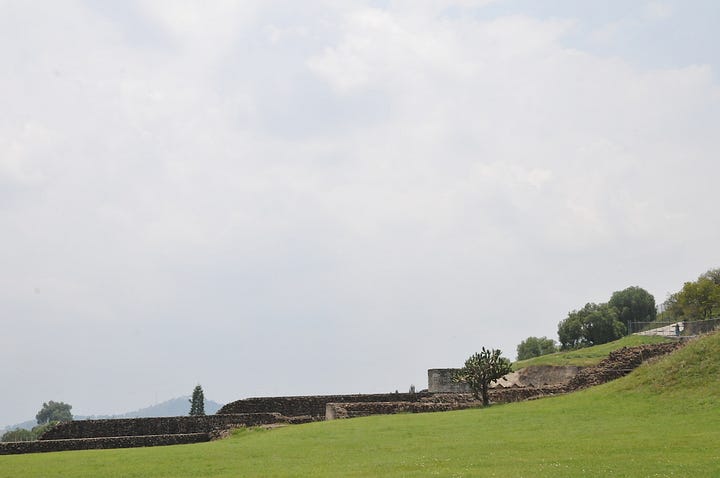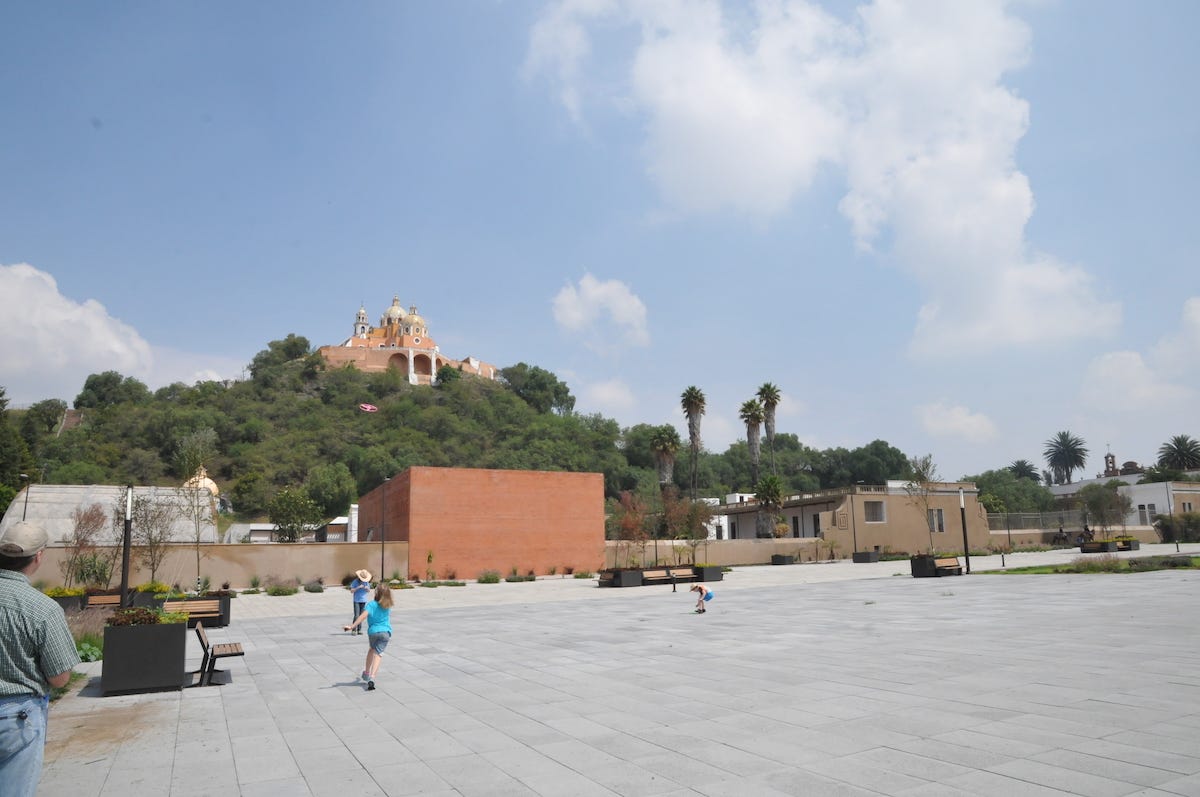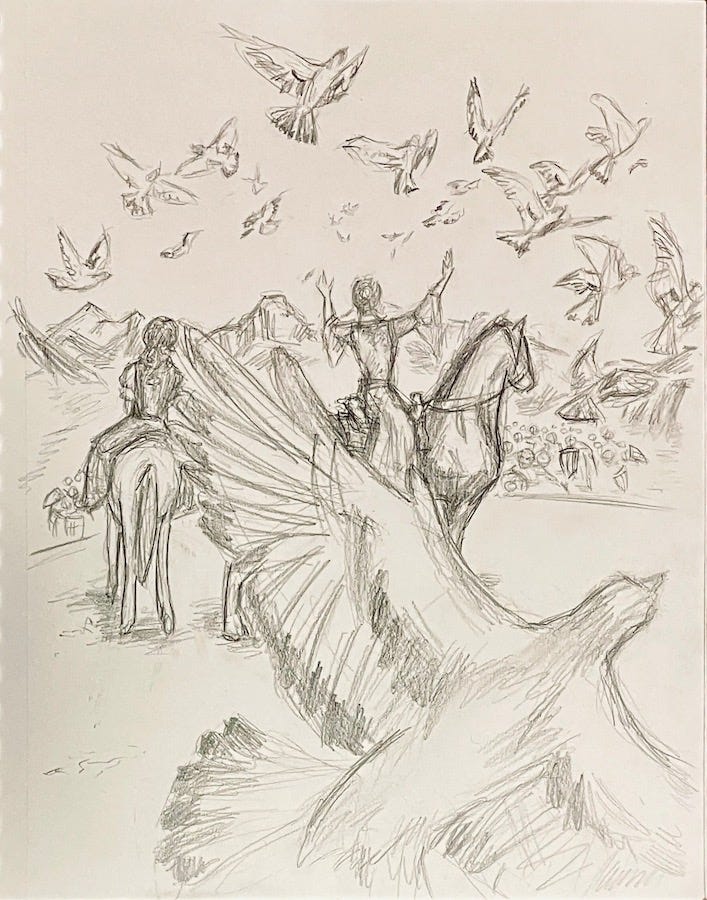I’m currently taking a memoir writing class in The Habit, my online writing community. It’s a great opportunity to build up a few cohesive stories for this newsletter, and I thought you’d enjoy this experience that I wrote about for our exercise last week. This story comes from the summer of 2016, just before we left Mexico.
One of our family jokes is that Puebla City, Mexico, is flat. If you don’t know about this city or have never been there, this joke doesn’t mean a thing, but for anyone who has been there for more than the two days we were, you’ll probably squint your eyes in confusion, tip your head, and repeat, “Puebla is flat?”
Because the truth is that the valley of Puebla City is circled by mountains and four volcanoes, two of which are active. The most famous of these, Popocatépetl, was the one we’d particularly looked forward to seeing. Its snowy, smoking conical peak is often pictured in the background of the great pyramid mound and cathedral of the town of Cholula. We knew this from guide books and friends who’d seen it. For us, though, during the days we were there, all of the surrounding mountains were invisible.
It wasn’t stormy. It wasn’t even foggy. The sun shone, and large cumulus clouds hung in the sky. The only indication that there was something off in the atmosphere was a slight haziness along the horizon. We strained our eyes, gazing into sky, and saw…nothing.
It’s hard to see clearly when you don’t know where to look. This was part of our problem. I had one moment when I was peering out our hotel window and I suddenly saw an angled line of a slope in the distance. I excitedly called Kraig and our kids over to see, and for a few minutes we ogled the sign that there was something massive out there. We could follow the line to where it disappeared and imagine just how far it went, and how big the mountain was. When it vanished, though, I couldn’t even pinpoint where I had seen it.
Our goal during our time in Puebla was to visit the mound and cathedral in Cholula. We drove to the historical site, hoping the half-hour distance from the metropolis of Puebla might lift the veil on Popocatépetl. It didn’t, but the temple mound was easy to find, and we parked and entered the site. The hill is actually the location of the largest pyramid in the world, by volume. While archeologists didn’t start excavations till the 1930s, everyone knew there was a temple there, hidden by earth and trees. The Spaniards who colonized the area in the 1500s had no doubt, which is why they built their elegant ochre and white cathedral on top of it. Christ had conquered the ancient gods, seen and unseen. The goddess of rain was now Mary of the Remedies.
We climbed the hill, visited the cathedral, and checked out the view. Cholula lay below us, a sprawling town—we could see miles of it. But at the place where we knew Popocatépetl stood we saw…nothing. The sun shone down merrily, great puffy clouds sailed the blue skies, but the horizon was a hazy blank.
I believe the photos I’ve seen. The mountain does exist. I even bought a little souvenir that shows the iconic image of the mound and cathedral and Popocatépetl smoking away behind them. In my mind I can see it, even though my physical eyes never did. It is just as real as the excavated passageways of the temple under the mound that we wended our way through, a place of complete darkness that electricity illuminated for us so we could see.
At the bottom of the mound, outside in the ancient court, we browsed the ruins of altars, contemplating one that memorialized the end of a drought. A plaque informed us that the bones of six and seven year old children were found there when the altar was excavated. The priests had sacrificed them to the rain goddess. I was glad I couldn’t see the bones, but from where we stood, we could just make out the cathedral claiming the hilltop, and we pondered the fact that, despite known atrocities committed by Spanish colonizers, what they put an end to was even worse. Even God used the Babylonians to end the idolatry of Judaisms. It’s an old, old tale. I don’t understand how it all works in God’s sight, but now and then the veil lifts and I see a bit of the glorious truth of it.
On the day we drove away from Puebla, I caught a final glimpse of the slope of one of the volcanoes. It lurks in my memory, and I still find myself straining my mental eyes, trying to see it clearly. I want to go back and really see it all because I know it is there. For now, though, our family will continue to joke about flat Puebla City. It eases the ache a little, that sorrow that we hold because we could not see clearly, and that because of the veil we missed something magnificent.


Art for the week
I missed including some recent art for you in my last post—it’s harder to get new pieces from my daughters when they’re living away from home! But Clare shared a few of her newer drawings with me recently, so I’ll pass this one along to you today:
Check out Daughter of Arden at Bandersnatchbooks.com, along with other great titles.
You can find links to more of my writing at A Shaft of Sun Through the Rain and my old blog, Willing, Wanting, Waiting.
Don’t forget to check out Bandersnatch Books’ podcast—they’ve got a new season going with great author interviews. Or you can dig back into season 1, episode 2 for my interview!






I like how you took not being able to see the volcano that you knew/believed was there and made it a metaphor for that other reality that we know/believe but can't see with our eyes. And you were also able to have a little fun with it!
Such a great piece.